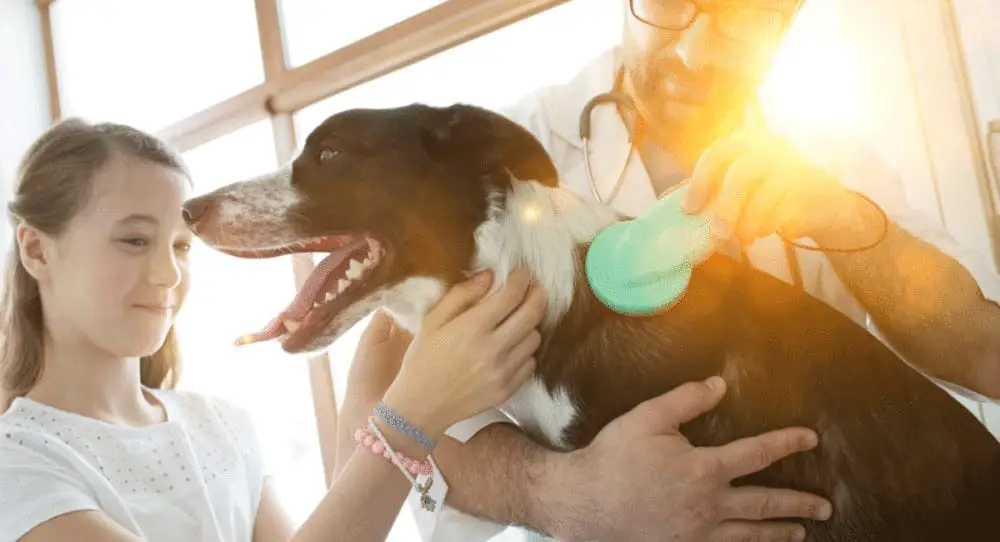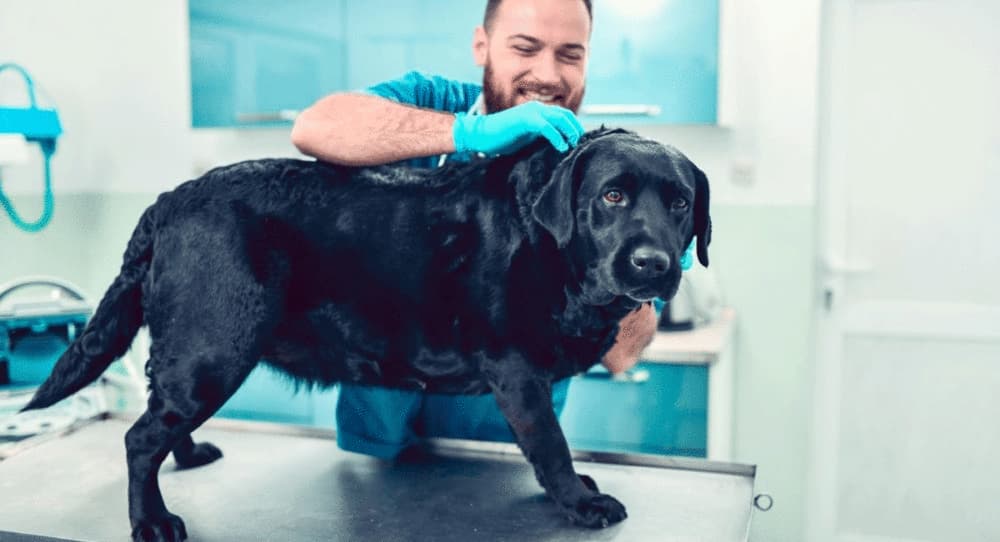If your dog’s head feels hot, it’s essential to determine the underlying cause as soon as possible. Dogs usually have a body temperature of 101-102.5 degrees Fahrenheit, but there are several reasons why a dog’s head may feel hotter than usual.
In this blog post, we will help you understand “Why is my dog’s head hot?”. We will explain the most common causes of a hot head in dogs and provide guidelines on measuring a dog’s body temperature.
Average Body Temperature Of Dogs
If your dog’s head feels hot and you’re concerned that your furry friend may be running a fever, it’s essential to know his or her average body temperature.
The easiest way to measure your dog’s body temperature is by using a rectal thermometer. This can be done at home or by your veterinarian. When taking your dog’s temperature, be sure to use a lubricant such as petroleum jelly to make it easier and less painful for them.
Can You Test Your Dog’s Temperature By Its Nose?
One of the things that people often ask is whether or not it’s possible to check a dog’s temperature by touching its nose. Unfortunately, there is no scientific evidence to support the belief that this method works. Some individuals may be able to tell if a dog has a fever based on behavior alone.
It’s always best practice when monitoring your canine companion’s health status to take an accurate body temperature reading with either rectal or oral thermometers.

Reasons Why Your Dog’s Head Feels Hot
There are many reasons why your dog’s head could feel hot, but the most common ones include fever, natural cooling mechanisms, stress, and everyday occurrences.
Fever:
Dogs can develop a fever for many reasons, including infections (viral or bacterial), allergies, and immune system issues. If you notice that your dog’s head feels hot and he or she is exhibiting other fever symptoms such as lethargy or loss of appetite, it’s essential to take your dog to the vet immediately.
Your veterinarian will first test for fever and check your dog’s temperature with an oral thermometer. A rectal thermometer might also be used if necessary, but qualified professionals should only perform this method due to its invasive nature and potential risks associated with improper use.
Natural Cooling Mechanism:
Dogs have some natural cooling mechanisms that help them regulate their body temperature, including panting and sweating through their paw pads. If your dog is active and the weather is hot, he or she may be more prone to overheating. In these cases, it’s essential to provide plenty of fresh water and ensure that your dog has access to a shady spot where he or she can rest.
Daily Unharmful Occurrences:
Dogs can also experience a temporary increase in body temperature for no apparent reason. This is often referred to as “normal” fever and is usually nothing to worry about. Common causes of normal fever include excitement, exercise, anxiety, and stress. Most cases of normal fever will resolve on their own within a few hours or days.
If your dog’s head feels hot and you’re not sure whether or not it’s cause for concern, it’s always best to consult with your veterinarian. They will give you a more accurate diagnosis and recommend the appropriate course of treatment.
Symptoms Of Fever In Dogs:
- Lethargy: A dog with a fever will have less energy than usual and may even seem depressed.
- Loss of appetite: Dogs typically lose their appetite when they’re not feeling well, so this could be another sign that your furry friend might be running hot.
- Panting or heavy breathing: If you notice your dog panting more often than usual, it could mean that something isn’t right in its body temperature regulation system (such as fever).
This symptom alone doesn’t necessarily indicate illness but, combined with other changes like lethargy and loss of appetite, should prompt an immediate trip to the vet.
- Changes in behavior: It’s not uncommon for sick dogs to act differently than usual. Some examples include hiding under furniture or avoiding social interactions with humans or other animals.
If you see these signs, it’s essential to take your pup in for veterinary care as soon as possible so they can get the treatment they need before things get worse.
- Vomiting: Some viruses cause vomiting, leading to dehydration if left untreated.
- Diarrhea: Dogs with diarrhea may also become dehydrated.
- Rash or redness on the skin: A fever may cause your dog’s skin to redden and feel warmer than usual.
- Increased body temperature: Dogs’ normal body temperature ranges from 100 to 102.50 degrees Fahrenheit (37.78 to 39.17 degrees Celsius). If you notice that your pup’s head feels hot and his or her temperature is higher than this, it could be a sign of fever.
It’s important to remember that many of these symptoms are not necessarily caused by fever alone. Some dogs will exhibit changes in behavior even when there isn’t anything medically wrong with them.
What Happens And What To Do If Your Dog Seems Too Hot?
If your dog’s head feels hot, give your pet some cool water and perhaps some ice. You should also monitor body temperature regularly while they’re resting or sleeping so that you can tell if it starts going up again in the meantime. If this happens, take your dog back home immediately for more rest until normal levels return.

It’s common for dogs to overheat when exercising outside on hot days, but keep an eye out for any signs of discomfort such as panting heavily with tongue hanging out of the mouth (these could indicate heatstroke).
A good rule of thumb is if it’s over 90 degrees Fahrenheit (32 degrees Celsius) inside your house during summertime, don’t let your dog run around too much. Instead, provide them with plenty of water and take regular breaks in an air-conditioned room.
Dogs can die from overheating, so if you think your pup might be suffering from heatstroke, don’t wait: get help! Suppose your dog’s temperature reaches 103 degrees Fahrenheit (39.44 degrees Celsius) or higher. In that case, it is considered a medical emergency and you should seek veterinary care immediately as this could be indicative of heatstroke. Some symptoms of heatstroke include: vomiting, diarrhea, lethargy, pale gums, bright red tongue and seizures.
At What Temperature Should You Not Walk Dogs?
If it’s above 90 degrees Fahrenheit (32 degrees Celsius), don’t walk your dog for more than 20 minutes at a time. Make sure that you provide him with plenty of water. If you can, try running an air conditioner where your pet is sleeping so that when he comes inside after being outside, they can cool down.
You should also avoid taking your dog out in temperatures below 50 degrees Fahrenheit (0 degrees Celsius). The cold can cause hypothermia and frostbite, leading to death if left untreated. However, if you do need to take your pup outside during these times, make sure he or she wears proper clothing like boots or sweaters and a jacket or coat.
How To Cool Down An Overheated Dog?
If your dog feels hot, you can help them cool down by spraying their head and body with a hose or giving them a cold bath. You can also put ice packs on their neck, groin, and armpits. If your dog is panting heavily, try to get him or her to drink lots of water.
Dehydration is another issue that can develop when dogs overheat, so keep an eye out for symptoms like: excessive thirst, dry mouth, reduced urination, sunken eyes, and lethargy. If you think your pup might be dehydrated, then take him or her to the vet as soon as possible.
Fever in dogs is usually caused by infection, but it can also be due to other conditions like heat stroke or food poisoning. It’s essential for your dog to recover, because dehydration is another issue that can develop when dogs overheat. Keep an eye out for symptoms like excessive thirst, dry mouth, reduced urination, sunken eyes, and lethargy. If your pup has a fever, make sure they get plenty of rest, water, and food. If you think your pup might be dehydrated, then take him or her to the vet as soon as possible.
“My Dog’s Head Is Hot”- Now You Know Why, And How To Address It
If you’ve been worrying about “my dog’s head is hot!”, it might not be anything to worry about… but you should still monitor their body temperature just to be safe. If the fever persists or they start showing any other signs of illness, take them to the vet as soon as possible.






